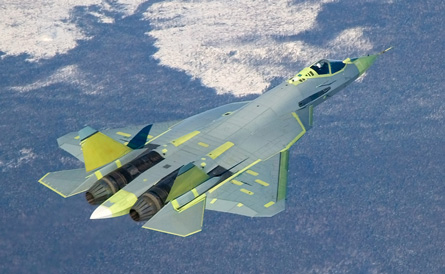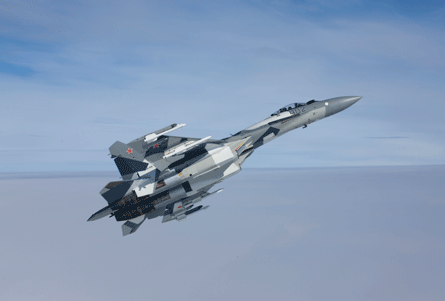Senior officers in Russia's air force can see glimmers of light after the gloom of the 1990s and early 2000s. The question is whether these glimmers are yet another false dawn.
A series of plans to revitalise the service have come to nothing. The country's 10-year, Rb20 trillion ($700 billion) defence plan shows signs of being more realistic, but depends on a continued flow of money from the country's treasury.
"If you're an optimist you perhaps think that the Russian air force has finally turned the corner," says Douglas Barrie, senior research fellow for military aerospace at London's International Institute for Strategic Studies.
"Over the past few years grandiose and undeliverable acquisition plans have been watered down for more credible packages," he says. However, even this more credible approach is totally dependent on funding continuing to materialise. Previous funding plans have been back-loaded in terms of acquisition funds, and these funds tended not to arrive.
 |
|---|
© Sukhoi |
The state's income over the past three or four years has generally been healthy, particularly because of high prices for oil and gas, but it will take a significant, sustained effort to turn around the air force after a decade and a half of stagnation following the end of the Cold War.
"The signs are that if the current 2011-20 procurement plan is implemented in full, that would give stabilisation and the beginning of an upward curve, although a very gentle one," says Barrie.
"But there are still a lot of questions as to whether that plan will ever be fully implemented, because it's still pretty ambitious. It calls for 600 aircraft and 1,000 helicopters. In 2011 alone it called for about 100 helicopters."
The air force's structure has been overhauled, with four geographic air defence regions created - western, central, eastern and southern - along with Moscow-based military transport, long-range aviation and strategic commands.
Base structure has been amended accordingly, with a series of central bases, such as Voronezh, some 600km (370 miles) south of Moscow and Viazma, west of the capital, supported by a series of satellite airfields.
This is being accompanied by a gradual move towards more multi-purpose combat aircraft, notably the Sukhoi Su-27SM2 - known in the West by its Su-35 export designation. An order for 48 is under way, with the aim of using the type as a bridge between current models and the fifth-generation Sukhoi T-50 designed to meet the air force's PAK-FA requirement and create an equivalent to the Lockheed Martin F-22 Raptor.
Two prototypes of the T-50 are now flying at the Gromov flight test centre at Zhukovsky, in the Moscow suburbs, although Barrie feels that reported plans to have the type in service by 2014-15 are optimistic, and that it would be more realistic to expect the type to be in service in unit strength by 2018-20.
The T-50 programme will accelerate as quickly as the developers can handle it, and Barrie sees no reason why the aircraft should not be a valuable addition to the air force inventory: "After all, Russian designers brought you the Flanker and Fulcrum, which were more than adequate aircraft," he says.
Meanwhile, some existing Su-27s have been through an upgrade and the air force is still looking at upgrading some of its MiG-29s, as well as taking on 35 MiG-29SMT/UBs rejected by Algeria after allegations of inferior build quality.
The Su-27SM2 is "a pretty capable platform and, if fought appropriately, would be a credible adversary," says Barrie. "The top-end Russian pilots are very good. The question is more about the level of training and the doctrine that underpins that." Currently, Russian pilots are believed to fly around 80 hours a year, which Barrie describes as "still not adequate, but better than it was". NATO pilots typically fly 140-160 hours a year.
The new Yak-130 advanced trainer is starting to appear, although in very small numbers. This is due to replace the 1970s vintage Czech-built Aero L-39 Albatros. The Yak-130's glass cockpit means "you can train much further up the syllabus before you finally put someone in a combat aircraft, which gives considerable cost and training advantages", says Barrie. However, that advantage will only be maintained if young pilots then transition to another glass cockpit in their front-line unit, rather than an old analogue "office".
 |
|---|
© Sukhoi |
If the T-50 is the equivalent of the F-22, one question still to be answered is whether and when a counterpart to the Lockheed Martin F-35 Lightning II will appear. Several Russian design bureaux have talked about producing a new medium fighter that would replace the MiG-29, but nothing firm has yet materialised and Barrie feels any such design will be five to 10 years behind the T-50.
Similarly, a new long-range bomber, known as PAK-DA, intended as a supplement or replacement for the Tupolev Tu-160 Blackjack, Tu-22M3 Backfire and the antiquated Tu-95MS Bear is still some considerable way off. Even the talked-about 2025-30 timespan is, he feels, ambitious, given the resources that would be required to develop it.
One step down from the PAK-DA, the first examples of a long-range interdictor, the Su-34, are reported to have been delivered to the Voronezh base last year, although this programme has been severely delayed.
Also badly needing renewal is the service's transport fleet. Last year, the Russian government promised to order new examples of the Antonov An-124 Ruslan outsize transport and the updated Ilyushin Il-476 strategic airlifter, an Il-76 with a digital flight control system, glass cockpit and Perm PS-90A-76 turbofans for improved fuel efficiency.
Alexei Fedorov, then president of United Aircraft, went so far as to say that "over 50" would be built between 2015-20. As far as is known, neither order has yet been finalised.
The Ukraine-built Antonov An-70 transport, on which the Russian air force has blown hot and cold for several years, appears to have acquired a new lease of life, with Russia again backing the programme. However, Barrie says: "You just get the sense there's an awful long way to go before you've got that aircraft ready to go into service."
Another potential contender for the transport role is the UAC/Hindustan Aeronautics Il-214 Multi-role Transport Aircraft, a medium-lift turbofan transport that, in Indian service, is due to replace the Antonov An-30 twin-turboprop.
However, more important for both Russia and India is New Delhi's proposed Fifth Generation Fighter Aircraft, a modified version of the Sukhoi T-50. India's rising stature as a political and military power has led it to build on its long-standing relationship with Russia and bid for a leading-edge military capability in the form of this advanced combat aircraft.
Barrie believes that India has basically bought its way on to the programme, and that it will provide an extremely valuable funding stream for the aircraft's development.
India regards it as very much a joint Indo-Russian programme, but essentially the project will remain Russian-controlled, says Barrie. "It's 'joint' only in the sense that it's jointly funded."
India is keen to have influence on the aircraft through its substantial financial stake, but Barrie says he believes any modifications will essentially be "around the edges", in the same way that some Indian members of the Su-27 family contain a proportion of western and Israeli avionics.
Like NATO, Russia finds itself having to cope with a changed strategic landscape in which most long-standing landmarks have been swept away. "The Soviet air force and military was geared towards top-end warfare - charging across the Fulda Gap and getting to Paris before the Americans could arrive en masse," says Barrie.
While top-end warfare remains in the military textbook, officers have to study new chapters on counter-insurgency and mid-level campaigns, but without equipment fitted to the latter roles and with money still relatively tight.
Russia continues to have concerns about what it calls its "near abroad" - its southern frontiers. Problems with Chechnya and Georgia remain unresolved and there are worries about rising levels of Islamist influence and violence in former Soviet territories such as Kyrgystan.
On a more strategic level, Moscow is watching the rapid rise of China with the same wariness as the US.
While China provided a desperately needed revenue stream when it purchased military aircraft in the 1990s and the early years of this century, Barrie says there is an obvious tension between generating revenue and effectively arming a peer rival.
Relations with Beijing have also been affected by China's construction of the J-11B fighter, an unlicensed, updated version of the Sukhoi Su-27 Flanker. The emergence of the J-15 carrier-borne fighter prototype also likely rankles in Moscow.
"It appears they got their hands on a prototype Su-33 via Ukraine, took the Flanker airframe and stuck Chinese propulsion, avionics, radar and weapons in it," says Barrie.
Summing up, the flow of new aircraft to units of the Russian air force remains modest, but the situation is considerably better than in the 1990s, when none were emerging from the factories.
To improve, the pace of receiving new aircraft has to quicken, while basing and training strategies need to be fully implemented and a new range of air-to-ground precision-guided weapons needs to be introduced to replace the AS-10 Karen family.
All this will depend on cash continuing to flow from the country's exchequer, allowing the service to recover from its near-death experience in the 1990s.
Source: Flight Daily News
















